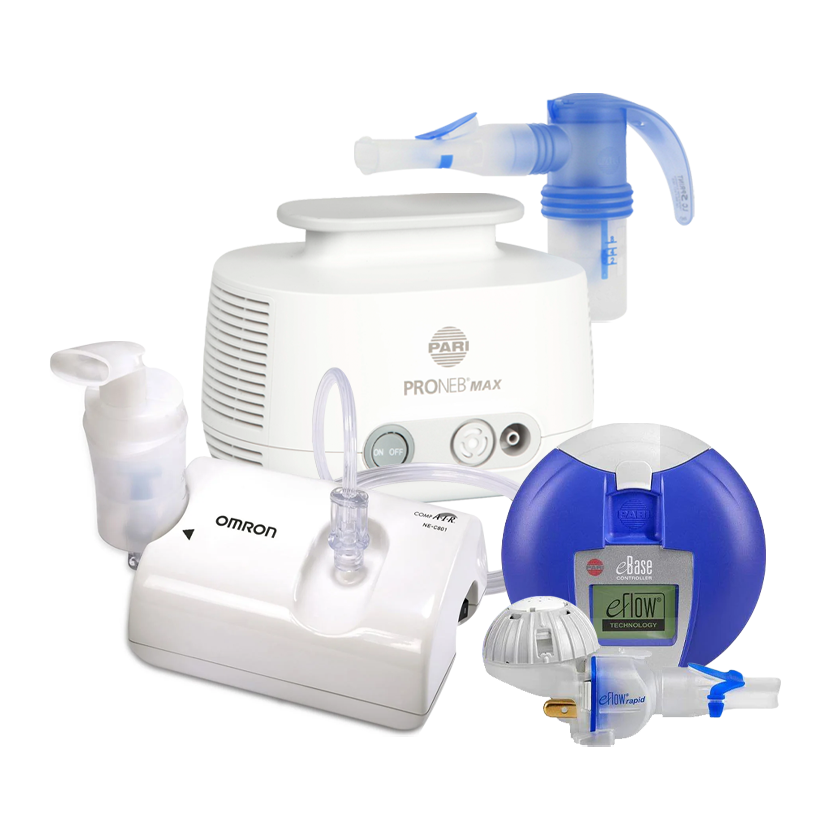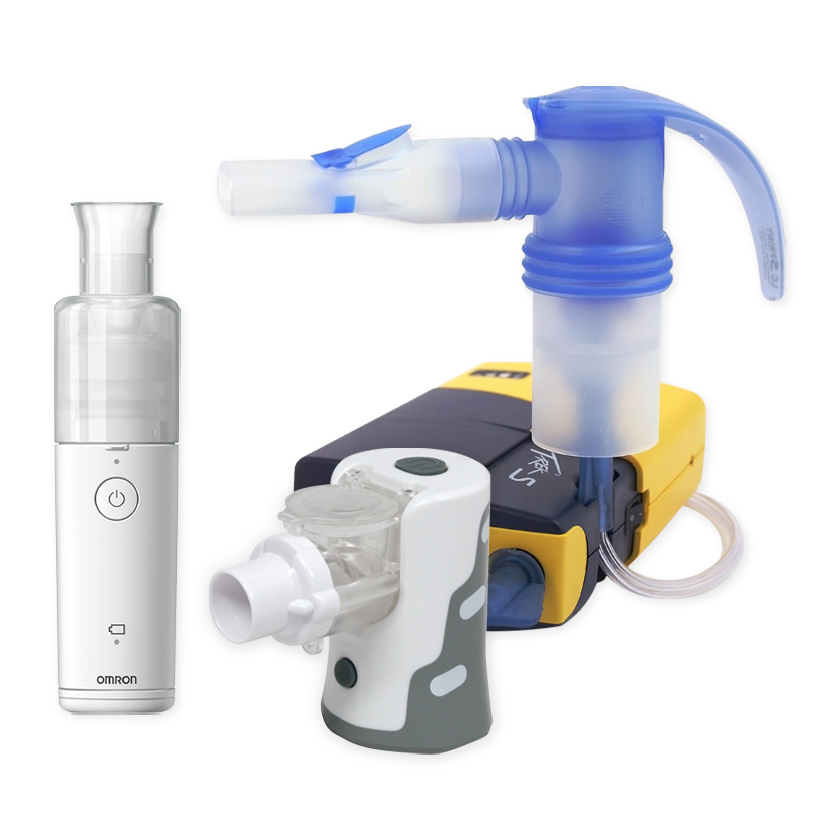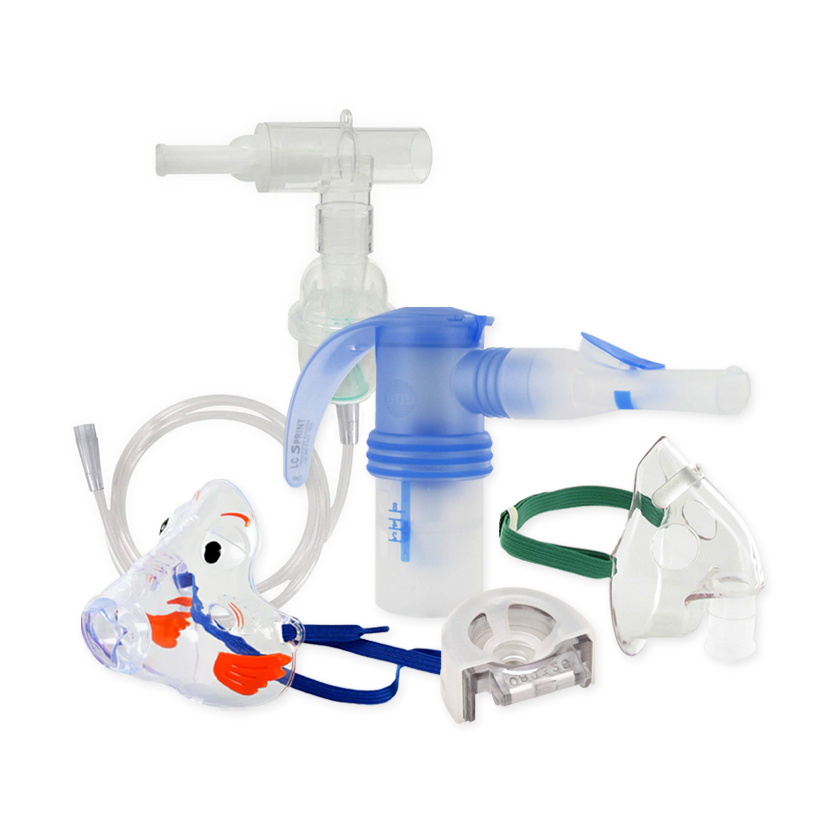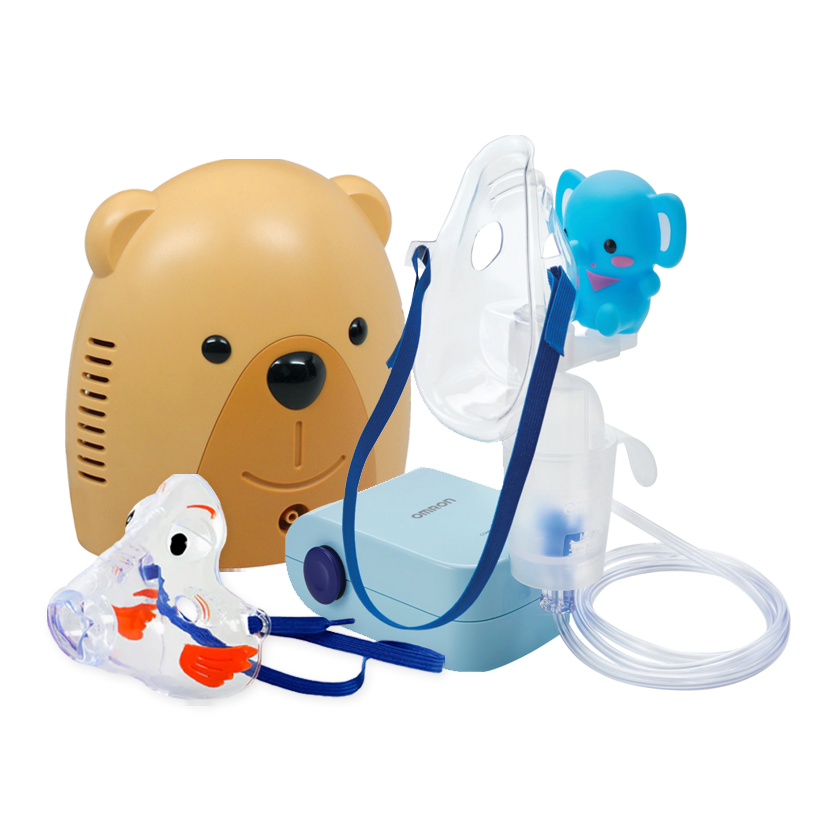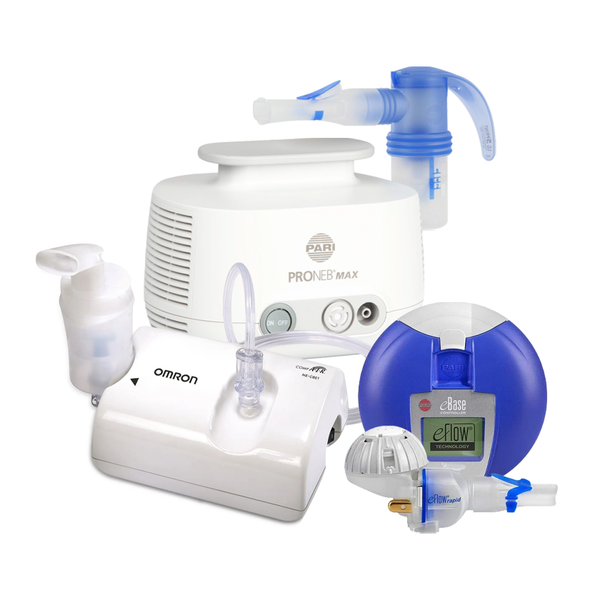Your Cart is Empty
Tips & Advice Center: General Nebulizer Information

What is a Nebulizer? >>
How Do I Use a Nebulizer? >>
How Do I Set Up a Nebulizer? >>
Proper Use of Your Nebulizer >>
Know Your Nebulizer Parts >>
Guide to Nebulizer Accessories >>
Medications Used with Nebulizers >>
Nebulizers and Caregivers >>
Choosing a Nebulizer: Tabletop or Portable? >>
Buying a Nebulizer, Parts, and Accessories >>
How Do I Shop for a Nebulizer? >>
Disposable Nebulizer Sets >>
How to Choose a Nebulizer >>
Replacing Your Nebulizer >>
Nebulizers, Accessories, and Price >>
Shopping Smart for Nebulizer Accessories >>
Tips for Fast and Easy Nebulizer Treatments >>
Nebulizer Types >>
Top 10 Nebulizer Terms >>
Best Nebulizer Handheld Set >>

What is a Nebulizer?
A nebulizer is a breathing machine used to treat lung conditions such as asthma, cystic fibrosis, and other respiratory illnesses. They administer medication in the form of a mist that's inhaled into the lungs and are often used in situations in which using an inhaler is difficult or ineffective. Nebulizers are also used to limit the side effects of medications like steroids by delivering the medicine directly to the respiratory system.
There are two types of nebulizers: atomizer jet and ultrasonic. The atomizer, or "compressor nebulizer," is the most common. This type uses an aerosol compressor to vaporize droplets of medicine. Ultrasonic, or "mesh nebulizers," use high-frequency sound waves to make liquid medicine breathable. While ultrasonic models produce results comparable to jet nebulizers, they offer faster delivery of medication and operate more quietly. With both types of nebulizer, the patient inhales vapor through a mouthpiece or face mask.
There are a variety of nebulizers on the market, ranging in price from $50 to around $200. Both the jet and ultrasonic nebulizer systems come in tabletop or portable models and a variety of accessories and supplies are available for each. Tabletop nebulizers are intended for home use, as they need to be plugged into an electrical outlet. Portable units are battery-powered and small enough to fit into a bag or purse for travel; however, they tend to be more expensive and require disposable or rechargeable batteries or a car power adapter to run.
Consult your healthcare provider to find the appropriate unit for your needs.

How do I Use a Nebulizer?
Successful nebulizer treatment depends on proper use and care of your nebulizer unit. Here are some instructions on using your nebulizer:
- Allow enough time in your schedule for each treatment. Depending on your nebulizer, you may be spending between 5 and 15 minutes receiving treatment.
- Make sure your unit, supplies, medications, and accessories are clean and ready to use.
- Get comfortable—you'll be spending your treatment time in one place, so make sure you have what you need. Feel free to watch TV, listen to music, read, or just relax during the process. It's recommended that you sit up straight to ensure proper delivery of medicine.
- Place the mouthpiece between your teeth and seal your mouth around it, or, if you're using a mask, put it on so that it's secure on the face with no gaps.
- Switch on the power and take slow, deep breaths from the mouthpiece or mask. Hold each breath for two to three seconds before exhaling.
- Treatment should continue until the medicine has been used.
- Sometimes, patients feel dizzy or strange during treatment. If this happens, remove the mask or mouthpiece, turn off the machine, and rest for 5 minutes before beginning again, then breathe slowly.
- When the treatment is finished, switch off the power, breathe deeply several times, and cough to clear secretions. Spit them into a tissue or basin.
- Wash hands thoroughly.
- Finally, check your nebulizer supplies and accessories to make sure you'll be ready for the next treatment.
If you experience continuing symptoms like dizziness or agitation, seek medical attention. Contact your healthcare provider to learn more about nebulizers.

How Do I Set Up a Nebulizer?
Follow these instructions for using standard nebulizers such as Mini Comp, CompMist, PARI, Omron, PulmoMate, Invacare, and DeVilbiss models:
- Identify the components and accessories of the nebulizer unit. You should have an air compressor, medication cup, mask or mouthpiece, tubing, and measuring device (medication ampule, syringe, etc.).
- Place your nebulizer (air compressor unit) on a table or stable surface.
- Plug in the electrical cord.
- Make sure all accessories and components have been cleaned and dried according to instructions.
- Wash hands thoroughly.
- Measure medication with the suggested measuring instrument, according to instructions.
- Open the top of the nebulizer cup and dispense the medicine in front of the cup. Close the cup.
- Attach the cup to the mouthpiece or face mask and connect the tubing to the compressor and the cup.
- Switch the compressor on and get ready for treatment.
Every nebulizer comes with specific instructions. Refer to these instructions before using for the first time.

Proper Use of Your Nebulizer
To get the best results from treatment, it's crucial to get information on proper nebulizer use and care before you begin. Keeping your nebulizer in working order will help to ensure successful treatment and minimize symptoms.
Here are some mistakes commonly made in nebulizer use:
- Using a type of nebulizer or medication that is not recommended by your healthcare provider.
- Using a nebulizer only upon the emergence of symptoms.
- Not knowing the proper assembly and operating instructions for a nebulizer.
- Not changing the filters, nebulizer cups, and tubing on a regular basis.
- Measuring medication improperly.
- For small children, attempting to use a nebulizer that isn't child-friendly.
Knowing common mistakes will help prevent misuse and minimized treatment. Contact your healthcare provider or contact the experts at Just Nebulizers for more information about the proper use and care of your nebulizer.

Know Your Nebulizer Parts
There are lots of models of nebulizer out there, and each one is a little different from the others. This general guide to nebulizer parts will give you a basic idea of what makes a nebulizer system function.
- Nebulizer compressor: The compressor is the base of the system. It pumps air into the medication cup to create a breathable mist.
- Nebulizer cup: This is the reservoir where measured liquid medication goes.
- Mouthpiece/mask: This is the opening through which the mist is inhaled. Most nebulizer sets come with mouthpieces, but masks are available for those who find them more comfortable or who have trouble wrapping their lips around the mouthpiece.
- Tubing: The tubing delivers air from the compressor to the medication cup.
- Tubing connectors: These connect the tubing to the compressor and nebulizer cup.
All manufacturers provide specific information about the nebulizers they make, so check your user's manual to learn more about your model. Also, check with your manufacturer for warranty and replacement information.

Guide to Nebulizer Accessories
If you're new to using a nebulizer, here is a quick guide to nebulizer accessories:
- Nebulizer mask: A nebulizer mask fits over the mouth and nose to deliver medication directly to the airways. Nebulizer treatments require a mask or mouthpiece. Masks come in different sizes, and most can be purchased for about $5.
- Nebulizer filters: These should be changed regularly in order to ensure the air you're breathing in is clean and that normal air contaminates do not get into your nebulizers. Make sure to purchase a filter that's compatible with your nebulizer. Using your nebulizer without the proper, clean air filter will cause normal air particles and contaminates to ruin your compressor. Many are available in multi-packs that cost between $5 and $10.
- Rechargeable nebulizer battery pack: If you have a portable nebulizer, a battery pack will ensure that your nebulizer is ready for use at all times.
- Replacement power adapter: Tabletop nebulizers need to be plugged in order to function.
- Carrying case: A carrying case helps protect your investment and makes traveling with a nebulizer more convenient. Many have pockets to hold smaller parts like masks and mouthpieces.

Medications Used with Nebulizers
There are different types of prescription asthma medications that can be used with an aerosol compressor (or nebulizer). These include:
- Quick-relief medications that are used to reduce airway inflammation, bronchial swelling, and overproduction of mucus.
- Long-term control medications that help manage symptoms on a daily basis.
Quick-relief medications such as albuterol will help relieve sudden asthma symptoms. They typically begin working 5 to 15 minutes after treatment and can usually be administered every 3 to 4 hours, depending on your healthcare provider's instructions.
Preventative medicines like steroids and mast-cell inhibitors help manage symptoms to keep flare-ups at bay. A bronchodilator can be used to improve airflow. Steroids (corticosteroids) are taken once or twice daily and work to control inflammation, and mast-cell inhibitors decrease inflammation.
Some medications are only compatible with certain types of nebulizers. Your healthcare provider will tell you which type will work with your medication.

Nebulizers and Caregivers
If your child or loved one requires breathing treatments and requires the help of a caregiver, it's important that any caregivers, school nurses, home health aids, or teachers who might administer treatment understand how to properly use a nebulizer. Also, there are steps you can take to make the process a little less nerve-racking.
- Try to arrange to demonstrate a complete nebulizer treatment for anyone who might administer treatment.
- Type up specific instructions for after-treatment nebulizer cleaning and leave several copies with caregivers. If you're worried that the nebulizer might not be cleaned properly, purchase disposable nebulizers. Also, include instructions for proper medication measurement.
- If your nebulizer system didn't come with one, purchase a carrying case to make storage easy and to ensure that all parts remain in one place.
- Consider purchasing a small, portable nebulizer for away-from-home treatments. The Omron Micro-Air Electronic Nebulizer System, for example, is cordless and tubeless, and fewer parts and pieces could reduce the chances of misuse or loss.
- Caregivers who are new to nebulizers might not be able to recognize when parts or accessories need to be replaced. Keep a chart to help you remember when it's time to reorder and replace.

Choosing a Nebulizer: Tabletop or Portable?
If you're wondering which type of nebulizer you should buy to treat your asthma or respiratory condition, start by talking to your healthcare provider. If you're able to choose between portable and tabletop models, consider your needs and the advantages of both.
Buy a tabletop nebulizer compressor for home if:
- You're able to be at home for all of your treatments.
- You prefer a more affordable nebulizer system.
- You would rather not worry about recharging batteries.
Buy a portable nebulizer if:
- You have a busy lifestyle and may not always be able to make it home for nebulizer treatments.
- You like to travel.
- You'd prefer a smaller model that's easy to carry with you.
Some people prefer to purchase both types of nebulizers for convenience. If you're unsure of which type to purchase, it might be best to go with portable models, as they offer greater versatility. For further advice, feel free to contact us.

Buying a Nebulizer, Parts, and Accessories
If you're purchasing a nebulizer for the first time, the multitude of models, brands, accessories, and suppliers makes it difficult to know where to begin. Consider the following nebulizer buying guide to keep from feeling overwhelmed:
- Your healthcare provider may be specific about the type of nebulizer you need. If not, ask him or her about the type of machine that is best for your health. Certain medications work best with specific types of nebulizers, and some medications have limitations for which nebulizers they can be used with.
- Find out what types of nebulizer accessories you need. Is the nebulizer for a child who needs a special mask or mouthpiece? Or do you need an adult nebulizer mask? Find a retailer that carries a full line of these products.
- Consider your lifestyle. If you travel, work, or attend school, portable nebulizers may work best for you since they're battery-operated and easy to carry. You may find that a combination of a home tabletop nebulizer and a portable unit suits your lifestyle. Buy from a retailer that offers both.
- Just Nebulizers carries a full line of nebulizers and accessories, offers secure checkout, and has helpful customer service that can assist you with product warranties and the equipment itself.

How Do I Shop For a Nebulizer?
Once your healthcare provider has recommended a nebulizer for your medication administration, you have the opportunity to choose the one best suited to your needs.
Though these needs are dictated by medical treatment, you may still have choices when it comes to brand, size, and other options. There are many suppliers of compressor nebulizers, breathing machines, and aerosol compressors, so it can be hard to choose where to shop. Follow these simple shopping tips:
- Look for a reputable dealer that carries a variety of brands, models, and accessories.
- If you're shopping for a children's nebulizer, look for a full selection to find one that appeals to your child. If you would prefer a versatile model, try a PARI nebulizer, which can be used with optional, kid-friendly accessories.
- Consider purchasing a convenient travel nebulizer for use when you're away from home in addition to a home tabletop unit.
- Compressor nebulizers are less expensive than other models, but they're also noisier than other units. Consider your comfort when making a selection.
- Decide whether you would rather have a disposable mouthpiece kit or one that will last longer. Disposable mouthpiece kits are non-valved, meaning they do not have a reservoir for medicine. Non-valved kits do not deliver medicine as effectively as longer-lasting units.
- Make sure the nebulizer you choose comes with a manufacturer's warranty, operating instructions, and all advertised components.
- Look for professional advertising, a full-service web page, customer satisfaction reviews, and a knowledgeable customer service team that can assist you.

Disposable Nebulizer Sets
For safety and convenience, disposable nebulizer sets are available. While reusable models can be used for longer (up to 6 months), disposable sets can make performing breathing treatments easier in some situations.
- Disposable nebulizer sets are commonly used by hospitals and emergency rooms due to patient volume. They're also often used in doctor's offices; in fact, many doctors send their patients home with the sets used in-office. If your doctor provides you with a nebulizer set, make sure to ask if it's disposable.
- Many models, such as the Sidestream High-Efficiency Nebulizer Set and the MICRO MIST Nebulizer Set, come with tubing, so all you need is a compressor to hook the nebulizer set into.
- Disposable nebulizer sets are great for travel. If you're not sure whether or not you'll have access to a good place to clean your nebulizer set after treatment while you're away, you can bring along some disposables to use with a portable compressor and throw them away after use. Priced at around $7 each, this is an affordable travel solution that will help ensure your safety.
- They're great for your child's overnight trips. Keep the reusable nebulizer set at home and send him or her to Grandma's house with a portable compressor and disposable nebulizer sets. This way, they can spend less time worrying about cleaning and more time having fun together. Also, you'll feel assured that your child is receiving hygienic treatment.
Most disposable nebulizer sets can be used for up to two weeks. This may vary, so read the manufacturer's instructions before use.

How to Choose a Nebulizer
A nebulizer is an investment in your health and wellness, and choosing a unit that fits your lifestyle and medical needs requires a lot of thought. When making your decision, keep these tips in mind:
- Talk to your healthcare professional about your symptoms, diagnosis, and treatment plan. If a nebulizer is the right treatment for you, find out what types of medicines will be prescribed and how often you will be using the nebulizer.
- Know where and when you will use the nebulizer. Depending on your lifestyle, you may need to purchase a unit for home use and a portable model for work, school, or travel. Battery-powered units like the PARI Trek S or Omron Micro Air are great for those who are on-the-go.
- Time constraints can play a role in your nebulizer selection. An ultrasonic unit will take less time per treatment than a compressor nebulizer (5 minutes rather than the average 15), and it will deliver 100% of the liquid medication you dispense, maximizing treatment and freeing your time for other activities. (Note: not all medications are approved for use with ultrasonic nebulizers. Check with your healthcare provider for compatibility information).
- If your child requires nebulizer treatment, shop for child-friendly models. A nebulizer can be intimidating for small children, but purchasing a model with cartoon characters or a fun theme will help make breathing treatments enjoyable and relaxing. One of the most efficient units on the market, the PARI Vios, is available in a version made just for children. Both units function the same way, but the color and accessories of the PARI nebulizer for children will help your child feel more comfortable during treatment.
Still not sure? For expert advice, call or email the team at Just Nebulizers.

Replacing Your Nebulizer
If you use a nebulizer to manage your asthma or another medical condition, you might be wondering when you'll need to replace your compressor or other components. Nebulizers last longer when properly cared for, and proper care involves checking the air filter frequently and changing it when necessary. Because a dirty air filter makes the compressor work harder, keeping it clean will extend the life of your machine.
Keeping your breathing machine clean is also important to ensure proper treatment and hygiene. Dust and particle build-up on your nebulizer and accessories can cause your machine to fail. Most systems should be replaced at least every 5 years. Making sure your nebulizer components are cleaned according to instructions will promote effective treatment and prevent the spread of germs.
While changing your air filter and cleaning your system properly are extremely important, plastic components do break down over time, and your nebulizer may eventually fail. When it comes time to replace your nebulizer system, choose one that will work with your specific medication (for example, the medication Pulmicort should not be used with ultrasonic nebulizers). Check with your healthcare provider or call us if you have questions about this.
If you haven't shopped for nebulizers lately, you might be surprised at the large selection of nebulizers, components, and supplies currently on the market. Choose from tabletop, portable, jet, mesh, and ultrasonic models. These units will help you save time and will make your treatment more effective.

Nebulizers, Accessories, and Price
If your doctor has prescribed a nebulizer system for you and you're concerned about the expense, there are some ways to cut down on costs and some things that are worth a little extra investment. Before purchasing, consult this quick guide to help you make the most of your money:
- It's important to buy high-quality nebulizers and accessories. This is an investment in your health, and a machine of lower quality might not be as effective.
- Most nebulizer systems come with the compressor, nebulizer set (which includes the tubing and mouthpiece), and medication cup. Some also come with masks and/or air filters. These items will eventually need replacement, but purchasing a system that's complete will save you from having to spend additional money right away.
- Nebulizers and accessories tend to be less expensive online than in stores. When purchasing online, try to order all the accessories you need at once. This way, you'll always have supplies on hand when you need them, and you'll also save money on shipping by having everything sent to you at one time.
- Replacing accessories and filters on time will help make your nebulizer system last longer, which saves you money in the long run. Nebulizer filters are not washable, so make sure to stock up on replacements. If you use disposable nebulizer sets, these also need to be replaced periodically (most models will last for up to two weeks–always check the manufacturer's instructions to make sure). Reusable nebulizer sets can be replaced less frequently.
- Look for special prices and shipping promotions. Just Nebulizers periodically offers reduced prices on popular nebulizers and accessories and sometimes offers free shipping.

Shopping Smart for Nebulizer Accessories
If you want to shop smart for nebulizer accessories, follow these tips:
- Replace any accessories that are worn, bent, discolored, or cracked.
- Keep extra accessories and parts on-hand, just in case.
- Many nebulizer parts and accessories are compatible and interchangeable, but you may want to stick to the original brand for continuity.
- If you like mixing brands, look for sales on the specific items you need.
- Know what you're buying. For example, nebulizer masks come in a variety of sizes. You'll need to find out what size you need to replace before placing an order. Also, know what types of filters, medication cups, and parts you need for your specific nebulizer.
- Keep records that list your nebulizer manufacturer and your system's model number. You may need this information when shopping for replacement parts.
- Only change the basic operating system after talking to your doctor. Some medications require a specific type of nebulizer in order to be effective.
- Take advantage of your supplier's customer service department. They can answer product-related questions for you and update you on relevant discounts and sales.
- Look for reliable retailers like Just Nebulizers that carry a full line of products to meet your needs.

Tips for Fast and Easy Nebulizer Treatments
Nebulizer treatments can become a daily chore, but with a few easy changes, you can speed up your treatment time and be on your way faster. Here are a few things you can do to decrease your treatment time:
- Check to make sure your filter is clean. A dirty filter will put unneeded strain on your compressor and can slow down your treatment.
- Be sure you nebulizer set is new. Disposable sets, which come with most compressors, are only meant to last up to 10 treatments. Reusable nebulizer sets can last up to 6 months. Be sure you keep your nebulizer set fresh and new.
- Get a breath enhanced reusable nebulizer set like the PARI LC Plus. It works by speeding up the treatment when you inhale, providing a better treatment, lower medication waste, and a faster treatment. Not only will your treatment be faster, but clean-up is a breeze because the PARI LC nebulizer sets are dishwasher safe.
- Consider getting a portable nebulizer so you can take your treatments in the car or on-the-go. Our most popular nebulizer is the Omron MicroAir which has an average treatment time of 10 minutes. It runs off AA batteries and is completely silent so you can take a treatment anywhere – even in a movie theater, and no one will know.

Nebulizer Types
There are three main types of nebulizer systems. The first and most popular is the compressor nebulizer. It is also known as a jet nebulizer and works by forcing compressed air into the medication cup to aerosolize the medication. This is the type of nebulizer most medical facilities use. A very popular type of compressor nebulizer is the PARI Vios.
The second type of nebulizer system is an ultrasonic nebulizer system. It works by vibrating the medication into an aerosol. It operates easily and silently, although it does have a few medication restrictions because it adds heat to the medications. Check with your healthcare provider before purchasing this type of nebulizer.
A subcategory of ultrasonic nebulizers is an electronic nebulizer. It works by vibrating a mesh or membrane to create an aerosol. Unlike an ultrasonic, it does not add heat to the solution so it does not have the same medication restrictions. Electronic nebulizers tend to be slightly more expensive than the other types. The most popular type of electronic nebulizer is the Omron MicroAir.
One other nebulizer, often categorized separately, is the portable or travel nebulizer. These can be compressor or ultrasonic nebulizer systems and generally are characterized by their ability to operate away from a traditional wall outlet – either by battery or car adapter. These are popular for people who are on the go and can even replace a standard tabletop unit.

Top 10 Nebulizer Terms
Here is a list of 10 common terms you will want to be familiar with when purchasing a nebulizer.
- Accessories – accessories are any item that is not standard on the nebulizer system. These can include masks, mouthpiece attachments, pacifiers, additional power sources, additional nebulizers, etc.
- Aerosol – medication vaper you can inhale.
- Compressor – this is the machine that pumps air into the nebulizer. It is often referred to as the nebulizer, but it is only responsible for compressing the air.
- Electronic nebulizer – these use a vibrating mesh or membrane to create an aerosol.
- Jet nebulizer – another name for a compressor nebulizer system.
- Medicine cup – the medicine cup is where the medication is poured prior to treatment. It houses liquid medicine before it can be aerosolized.
- Nebulizer – the handset that actually produces the aerosol. This is the part that actually does the work. It is connected to the compressor and the medication is aerosolized in it.
- Nebulizer tubing – most compressor nebulizers use tubing to connect the nebulizer to the compressor. The standard length for nebulizer tubing is 7 feet.
- Particle size – the size of the aerosol particles. The ideal range if 5-10 microns. Anything larger or smaller will not help in most treatments.
- Ultrasonic nebulizer – rather than using compressed air, this kind of nebulizer uses ultrasonic waves to aerosolize the medication. Usually smaller and more quiet than compressor nebulizers.

Best Nebulizer Handheld Set
Like many other things, nebulizer technology is getting better and more compact. It makes it much easier for you to breathe easily when you can keep handheld sets close by at all times so you can quickly connect them to your portable compressor.
Among the handheld nebulizer set options, three models standout. The PARI LC Sprint is one of the most popular nebulizer sets on the market. It is inexpensive yet reusable. It offers one of the shortest treatment times on the market because of the breath enhanced technology which causes the medication delivery to speed up when the user inhales and slow down when they exhale. It also reduces the medication waste. The set is very low maintenance and can even be washed in the dishwasher. Like any reusable nebulizer, it should be replaced every six months.
The Sidestream Plus Breath-Enhanced Nebulizer is also an inexpensive reusable nebulizer set. This unit has a five-jet venture design, again speeding up the treatment time. The Sidestream Plus is good for those who have low breath flow because it requires less pressure to open the valve than many other breath enhanced nebulizers.
One of the lowest cost options you can get is the MicroMist nebulizer set. This disposable, handheld set comes with mouthpiece, T and tubing. It can also be purchased with a 6” corrugated tube and is compatible with any standard compressor you choose. While the MicroMist has the lowest upfront cost, it must be replaced much more frequently and is often a more costly option for those who use nebulizers often. It also is not dishwasher safe and must be soaked in vinegar and water to disinfect, making it less convenient than other models which can be placed in the dishwasher.

